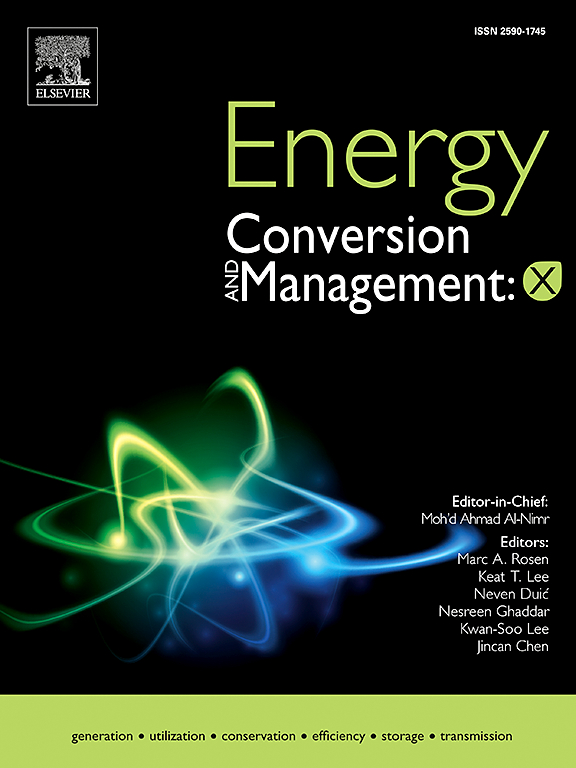Study of deposit accumulation and tribological degradation in diesel engine utilizing blend fuels
IF 7.1
Q1 ENERGY & FUELS
引用次数: 0
Abstract
Utilizing alcohol in diesel engines offers an alternative approach to reducing dependence on diesel fuel. Specifically, higher alcohols such as n-butanol (nB) and n-pentanol (Pn), which have high carbon content and are largely derived from non-edible sources, can be directly blended with diesel. These blends present significant economic and environmental advantages, making the study of high-carbon alcohol use in diesel engines increasingly important. This research focused on creating blends of waste cooking oil and n-pentanol with diesel fuel, preparing three binary and ternary mixtures: DF95WCO5 and DF65WCO20Pe20. The primary goal was to investigate the fundamental characteristics of these blends. However, challenges such as increased deposits, pollutant emissions, and reduced engine performance when using biodiesel have been noted. A detailed evaluation of combustion chamber deposit buildup and its impact on emissions and engine performance was carried out. The study employed diesel, waste frying oil, and n-pentanol blends. After 200 h of operation, engine injectors and pump pistons were examined using scanning electron microscopy (SEM) and energy-dispersive X-ray (EDX) analysis. It was discovered that waste cooking oil binary mix fuel had a greater rate of carbon deposition generation than diesel fuel, with 89.68% for WCO and 80.01% for D100. By contrast, engine part deposition was reduced when n-pentanol was mixed with waste cooking oil as opposed to diesel fuel, with a deposition rate of 47.90% for n-pentanol. The results revealed notable surface structure changes on pistons with DF95WCO5 and n-pentanol blends. Wear debris concentration was reduced when using emulsified fuels, particularly in binary blends, while the ternary blend DF65WCO20Pe20 showed further reductions in Cadmium (Cd), Iron (Fe), Copper (Cu), and Nickel (Ni) compared to pure diesel. The engine demonstrated lower viscosity and increased density when operated with these blended fuels. Experimental findings highlighted significant differences between biodiesel derived from used and fresh cooking oils, including reduced engine performance, higher carbon deposits, and accelerated metal degradation in key components of diesel engine lubricating oil.
混合燃料柴油机沉积与摩擦学退化研究
在柴油发动机中使用酒精为减少对柴油燃料的依赖提供了另一种方法。具体来说,正丁醇(nB)和正戊醇(Pn)等含碳量高且主要来自非食用来源的高级醇可以直接与柴油混合。这些混合物具有显著的经济和环境优势,使得研究在柴油发动机中使用高碳酒精变得越来越重要。这项研究的重点是将废食用油和正戊醇与柴油混合,制备三种二元和三元混合物:DF95WCO5和DF65WCO20Pe20。主要目的是研究这些共混物的基本特性。然而,当使用生物柴油时,诸如沉积物增加、污染物排放和发动机性能下降等挑战已经被注意到。对燃烧室积垢及其对排放和发动机性能的影响进行了详细评估。这项研究使用了柴油、废煎炸油和正戊醇混合物。运行200小时后,使用扫描电子显微镜(SEM)和能量色散x射线(EDX)分析对发动机喷油器和泵活塞进行了检查。研究发现,废食用油二元混合燃料的积碳率高于柴油,WCO为89.68%,D100为80.01%。与柴油相比,正戊醇与废食用油混合时,发动机零件沉积减少,正戊醇的沉积率为47.90%。结果表明,DF95WCO5和正戊醇共混后,活塞表面结构发生了显著变化。当使用乳化燃料时,磨损碎屑浓度降低,特别是在二元混合物中,而三元混合物DF65WCO20Pe20与纯柴油相比,镉(Cd)、铁(Fe)、铜(Cu)和镍(Ni)含量进一步降低。当使用这些混合燃料时,发动机表现出较低的粘度和较高的密度。实验结果强调了从废旧食用油和新鲜食用油中提取的生物柴油之间的显著差异,包括发动机性能降低、碳沉积增加以及柴油发动机润滑油关键成分中的金属降解加速。
本文章由计算机程序翻译,如有差异,请以英文原文为准。
求助全文
约1分钟内获得全文
求助全文
来源期刊

Energy Conversion and Management-X
Multiple-
CiteScore
8.80
自引率
3.20%
发文量
180
审稿时长
58 days
期刊介绍:
Energy Conversion and Management: X is the open access extension of the reputable journal Energy Conversion and Management, serving as a platform for interdisciplinary research on a wide array of critical energy subjects. The journal is dedicated to publishing original contributions and in-depth technical review articles that present groundbreaking research on topics spanning energy generation, utilization, conversion, storage, transmission, conservation, management, and sustainability.
The scope of Energy Conversion and Management: X encompasses various forms of energy, including mechanical, thermal, nuclear, chemical, electromagnetic, magnetic, and electric energy. It addresses all known energy resources, highlighting both conventional sources like fossil fuels and nuclear power, as well as renewable resources such as solar, biomass, hydro, wind, geothermal, and ocean energy.
 求助内容:
求助内容: 应助结果提醒方式:
应助结果提醒方式:


